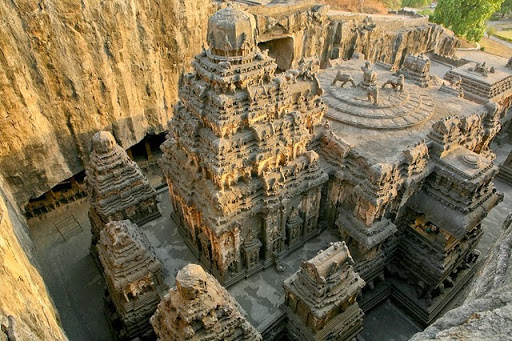Sri Kailasa Temple, Ellora

Address
Sri Kailasa temple Ellora, Aurangabad, Maharashtra.
Diety
Kailashanatha
Introduction
The Kailasha or Kailashanatha temple is the largest of the rock-cut Hindu temples at the Ellora Caves, Maharashtra, India. A megalith carved from a rock cliff face, it is considered one of the most remarkable cave temples in the world because of its size, architecture and sculptural treatment, and “the climax of the rock-cut phase of Indian architecture”.The top of the superstructure over the sanctuary is 32.6 metres (107 feet) above the level of the court below, although the rock face slopes downwards from the rear of the temple to the front. The Kailasa temple is the largest of the 34 Buddhist, Jain and Hindu cave temples and monasteries known collectively as the Ellora Caves, ranging for over 2 kilometres along the sloping basalt cliff at the site. Most of the excavation of the temple is generally attributed to the eighth century Rashtrakuta king Krishna I with some elements completed later. The temple architecture shows traces of Pallava and Chalukya styles. The temple contains a number of relief and free-standing sculptures on a grand scale equal to the architecture, though only traces remain of the paintings which originally decorated it.
Puranic Significance
Kailasa temple lacks a dedicatory inscription, but there is no doubt that it was commissioned by a Rashtrakuta ruler. Its construction is generally attributed to the Rashtrakuta king Krishna I based on two epigraphs that link the temple to “Krishnaraja” • The Vadodara copper-plate inscription of Karkaraja II (a ruler of a Rashtrakuta branch of Gujarat) records the grant of a village in present-day Gujarat. It mentions Krishnaraja as the patron of Kailasanatha, and also mentions a Shiva temple at Elapura (Ellora). It states that the king constructed a temple so wondrous that even the gods and the architect were astonished. Most scholars believe that this is a reference to the Kailasa Shiva temple at Elora. • The Kadaba grant of Govinda Prabhutavarsha similarly appears to credit Krishnaraja with the construction of the temple. However, the attribution of the temple to Krishna I is not completely certain because these epigraphs are not physically connected to the caves, and do not date Krishnaraja’s reign. Moreover, the land grants issued by Krishna’s successors do not contain any references to the Kailasa Temple .
Special Features
The Kailasa temple features the use of multiple distinct architectural and sculptural styles. This, combined with its relatively large size, has led some scholars to believe that its construction spanned the reigns of multiple kings. Some of the temple reliefs feature the same style as the one used in the Dashavatara cave which is located next to the temple. The Dashavatara cave contains an inscription of Krishna’s predecessor and nephew Dantidurga Based on this, art historian Hermann Goetz (1952) theorized that the construction of the Kailasa temple began during the reign of Dantidurga. Krishna consecrated its first complete version, which was much smaller than the present-day temple. According to Goetz, Dantidurga’s role in the temple construction must have been deliberately suppressed, as Krishna sidelined Dantidurga’s sons to claim the throne after his death. Based on analysis of the different styles, Goetz further hypothesized that the later Rashtrakuta rulers also extended the temple. These rulers include Dhruva Dharavarsha, Govinda III, Amoghavarsha, and Krishna III. According to Goetz, the 11th century Paramara ruler Bhoja commissioned the elephant-lion frieze on the lower plinth during his invasion of Deccan, and added a new layer of paintings. Finally, Ahilyabai Holkar commissioned the last layer of paintings in the temple. M. K. Dhavalikar (1982) analyzed the architecture of the temple, and concluded that the major part of the temple was completed during the reign of Krishna I, although he agreed with Goetz that some other parts of the temple complex can be dated to the later rulers. According to Dhavalikar, the following components were completed by Krishna: the main shrine, its gateway, the nandi-mandapa, the lower-storey, the elephant-lion frieze, the court elephants and the victory pillars. Dhavalikar admits that the most important sculpture of the temple, which depicts Ravana shaking the Kailasa mountain, appears to have been built after the main edifice. This sculpture is considered as one of the finest pieces of Indian art, and it is possible that the temple came to be known as Kailasa after it. Dhavalikar theorizes that this sculpture was carved around 3-4 decades after the completion of the main shrine, on the basis of its similarity to the tandava sculpture in the Lankeshvar cave. H. Goetz dated this relief to the reign of Krishna III. Like Goetz, Dhavalikar attributes some other structures in the temple complex to the later rulers. These include the Lankeshvar cave and the shrine of the river goddesses (possibly constructed during the reign of Govinda III). Dhavalikar further theorizes that the excavation of the Dashavatara cave, which began during the reign of Dantidurga, was completed during the reign of Krishna I. This explains the similarities between the sculptures in the two caves.
Century/Period/Age
8th century C.E
Managed By
Archaeological Survey of India (ASI)
Nearest Bus Station
Ellora
Nearest Railway Station
Ellora
Nearest Airport
Aurangabad,









